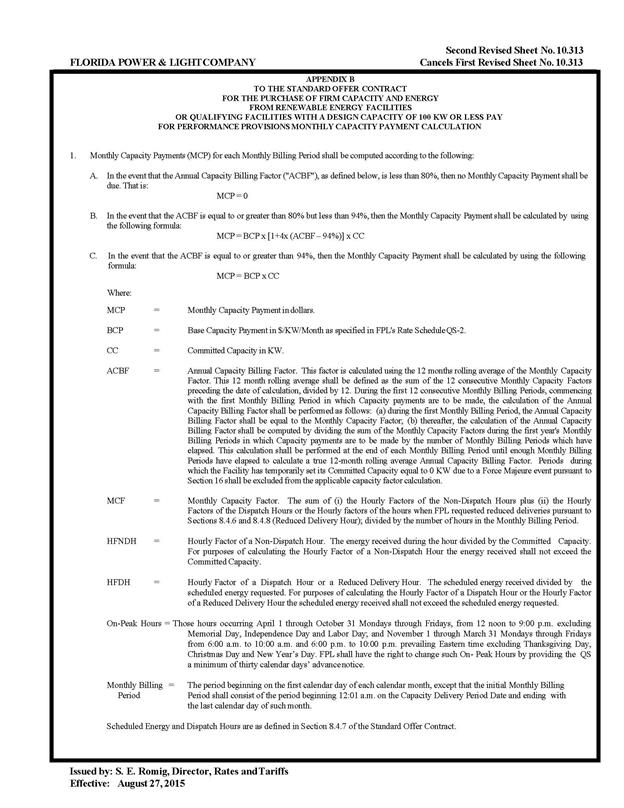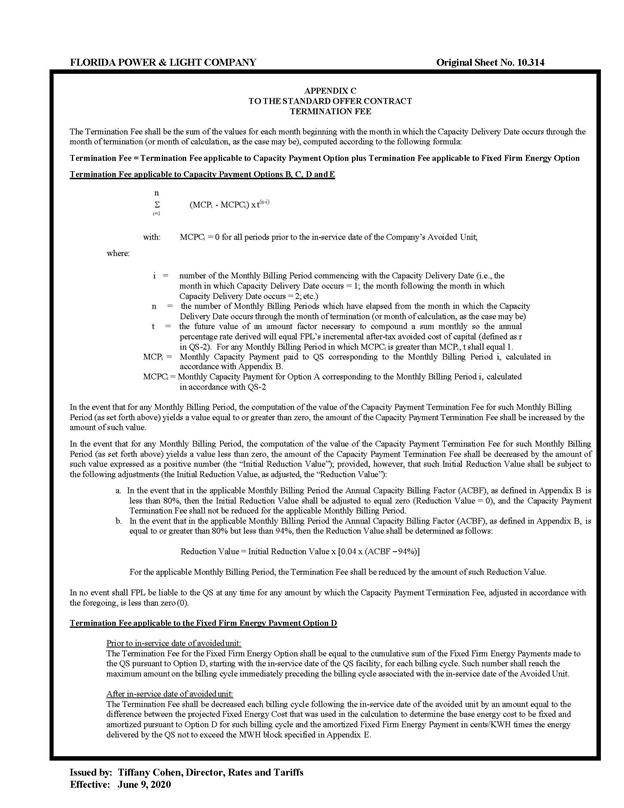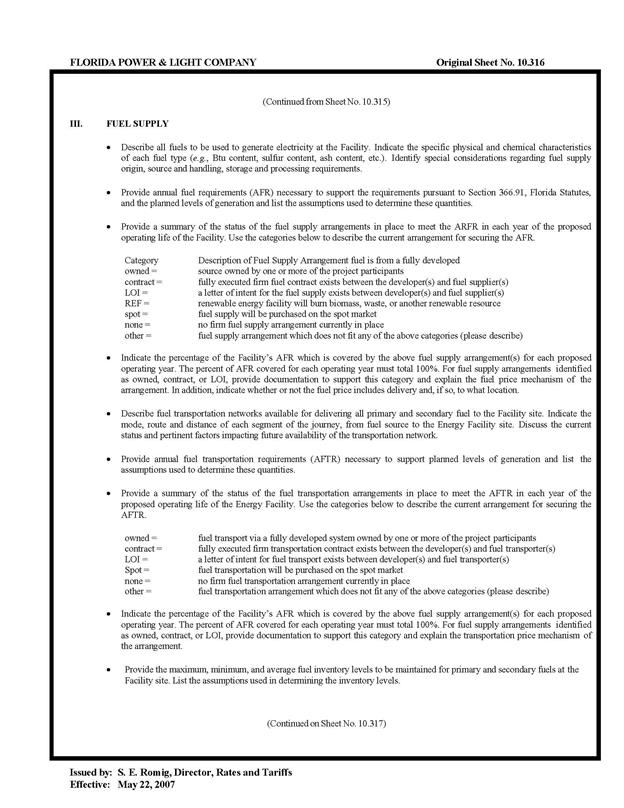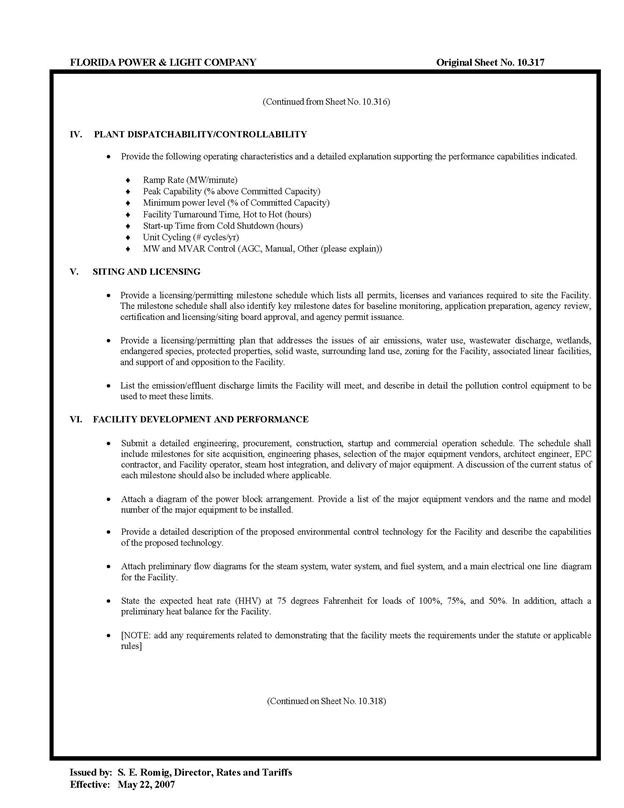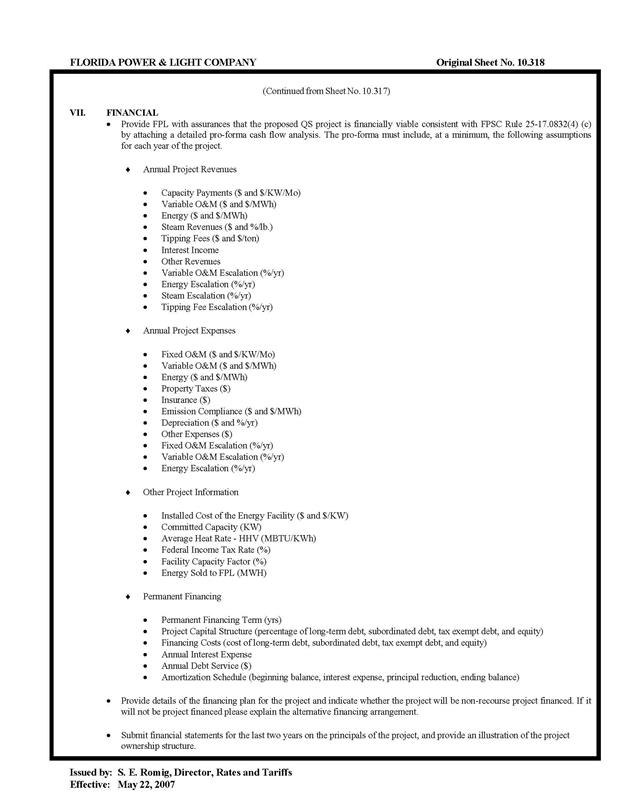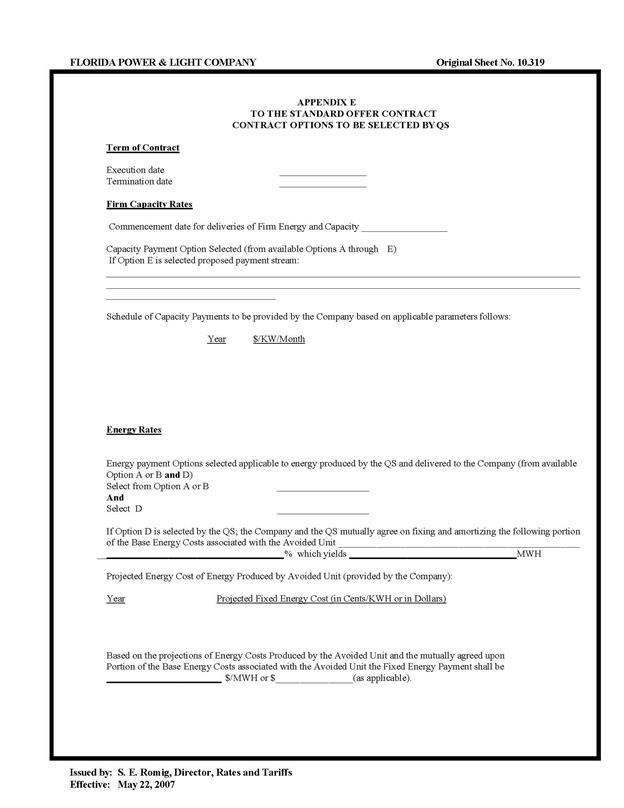†Case Background
Section
366.91(3), Florida Statutes (F.S.), requires each investor-owned utility (IOU)
to continuously offer to purchase capacity and energy from renewable generating
facilities and small qualifying facilities. Florida Public Service Commission
(Commission) Rules 25-17.200 through 25-17.310, Florida Administrative Code
(F.A.C.), implement the statute and require each IOU to file with the
Commission, by April 1 of each year, a revised standard offer contract based on
the next avoidable fossil-fueled generating unit of each technology type
identified in the utilityís current Ten-Year Site Plan (TYSP). On April l,
2022, Florida Power & Light Company (FPL) filed a petition for approval of
its amended standard offer contract based on its
2022 TYSP. The Commission has jurisdiction over this amended standard offer
contract pursuant to Sections 366.04 through 366.055, and 366.91, F.S.
Discussion
of Issues
Issue 1:
Should the Commission
approve the renewable energy tariff and the amended standard offer contract Florida
Power and Light?
Recommendation:
Yes. The provisions of FPLís renewable energy tariff and amended standard offer contract
conforms to the requirements of Rules 25-17.200 through 25-17.310, F.A.C. The
amended standard offer contract offers multiple payment options so that a
developer of renewable generation may select the payment stream best suited to
its financial needs. (Phillips)
Staff Analysis:
Section
366.91(3), F.S., and Rule 25-17.250, F.A.C., require that an IOU continuously
make available a standard offer contract for the purchase of firm capacity and
energy from renewable generating facilities (RF) and small qualifying
facilities (QF) with design capacities of 100 kilowatts (kW) or less. Pursuant
to Rules 25-17.250(1) and (3), F.A.C., the standard offer contract must provide
a term of at least 10 years, and the payment terms must be based on the
utilityís next avoidable fossil-fueled generating unit identified in its most
recent TYSP, or if no avoided unit is identified, its next avoidable planned
purchase. While FPLís 2022 TYSP does not feature an avoidable fossil-fueled
generating unit or planned purchases that could be deferred during the planning
period, FPL has identified a 1,991 megawatt (MW) combined cycle with a
projected in-service date of June 1, 2032 as the next avoidable planned
generating unit. FPL submitted two planning scenarios for its 2022 TYSP; and,
the avoided unit is identical in both scenarios. The
Commission has previously approved using a unit outside of the TYSP planning
period as the avoided unit for standard offer contract purposes.
Under FPLís standard offer contract, the RF/QF operator
commits to certain minimum performance requirements based on the identified
avoided unit, such as being operational and delivering an agreed upon amount of
capacity by the in-service date of the avoided unit, and thereby becomes
eligible for capacity payments in addition to payments received for energy. The
standard offer contract may also serve as a starting point for negotiation of
contract terms by providing payment information to an RF/QF operator, in a
situation where one or both parties desire particular contract terms other than
those established in the standard offer.
In order to promote renewable generation, the Commission
requires the IOU to offer multiple options for capacity payments, including the
options to receive early or levelized payments. If the RF/QF operator elects to
receive capacity payments under the normal or levelized contract options, it
will receive as-available energy payments only until the in-service date of the
avoided unit (in this case June 1, 2032), and thereafter, begin receiving
capacity payments in addition to †firm
energy payments. If either the early or early levelized option is selected,
then the operator will begin receiving capacity payments earlier than the
in-service date of the avoided unit. However, payments made under the early
capacity payment options tend to be lower in the later years of the contract
term because the net present value (NPV) of the total payments must remain
equal for all contract payment options.
Table 1
contains FPLís estimates of the annual payments for each payment option
available under the revised standard offer contract to an operator with a 50 MW
facility operating at a capacity factor of 94 percent, which is the minimum
capacity factor required under the contract to qualify for full capacity
payments. Normal and levelized capacity payments begin with the projected
in-service date of the avoided unit (June 1, 2032) and continue for 10 years,
while early and early levelized capacity payments begin four years prior to the
in-service date, or 2028 for this example.
Table 1- Estimated Annual Payments to a 50 MW
Renewable Facility
(94% Capacity Factor)
|
Year
|
Energy Payment
|
Capacity Payment
|
|
Normal
|
Levelized
|
Early
|
Early Levelized
|
|
$(000)
|
$(000)
|
$(000)
|
$(000)
|
$(000)
|
|
2023
|
10,849
|
-
|
-
|
-
|
-
|
|
2024
|
8,776
|
-
|
-
|
-
|
-
|
|
2025
|
8,929
|
-
|
-
|
-
|
-
|
|
2026
|
9,196
|
-
|
-
|
-
|
-
|
|
2027
|
8,917
|
-
|
-
|
-
|
-
|
|
2028
|
9,389
|
-
|
-
|
1,211
|
1,358
|
|
2029
|
10,160
|
-
|
-
|
2,102
|
2,328
|
|
2030
|
10,595
|
-
|
-
|
2,146
|
2,328
|
|
2031
|
10,861
|
-
|
-
|
2,191
|
2,328
|
|
2032
|
10,409
|
2,064
|
2,243
|
2,237
|
2,328
|
|
2033
|
9,958
|
3,582
|
3,845
|
2,284
|
2,328
|
|
2034
|
10,230
|
3,657
|
3,845
|
2,332
|
2,328
|
|
2035
|
10,527
|
3,734
|
3,845
|
2,381
|
2,328
|
|
2036
|
10,854
|
3,812
|
3,845
|
2,431
|
2,328
|
|
2037
|
11,023
|
3,893
|
3,845
|
2,483
|
2,328
|
|
2038
|
11,271
|
3,975
|
3,845
|
2,535
|
2,328
|
|
2039
|
11,445
|
4,058
|
3,845
|
2,588
|
2,328
|
|
2040
|
11,675
|
4,144
|
3,845
|
2,643
|
2,328
|
|
2041
|
11,743
|
4,231
|
3,845
|
2,698
|
2,328
|
|
2042
|
11,842
|
1,778
|
1,602
|
1,134
|
970
|
|
Total
|
208,651
|
38,927
|
38,450
|
33,396
|
32,599
|
|
Total (NPV)
|
103,307
|
13,382
|
13,382
|
13,382
|
13,382
|
Source: Response to Staffís First Data Request
FPLís standard offer contract, in type-and-strike format,
is included as Attachment A to this recommendation. The changes made to FPLís
tariff sheets are consistent with the updated avoided unit. Revisions include
updates to calendar dates and payment information which reflect the current
economic and financial assumptions for the avoided unit. In addition, the
language in Section 15, Sheet No. 9.042, which addresses insurance, has been updated.
The current language requires insurance with a minimum limit of one million
dollars per occurrence. The new language requires that, in addition to the one
million, the QF insurance shall have a two million dollar combined aggregate
limit for bodily injury or property damage. In response to staffís data
request, FPL states that the proposed change aligns with current market
conditions and is similar to other utilities.
For customer-owned net metering interconnections, Rule 25-6.065(5)(e), F.A.C.,
allows for up to $2 million in liability insurance for Tier 3 (100 kW to 2 MW)
installations. Staff believes the change to the language in Section 15 is
reasonable and consistent with other approved utility standard offer contracts
and net metering standards.
Conclusion
Yes. The provisions of FPLís renewable
energy tariff and amended standard offer contract conforms to the
requirements of Rules 25-17.200 through 25-17.310, F.A.C. The amended standard
offer contract offers multiple payment options so that a developer of renewable
generation may select the payment stream best suited to its financial needs.
Issue 2:
Should this docket be closed?
Recommendation:
Yes. This docket should be closed upon issuance of a
consummating order, unless a person whose substantial interests are affected by
the Commissionís decision files a protest within 21 days of the issuance of the
Commissionís Proposed Agency Action Order. Potential signatories should be
aware that, if a timely protest is filed, FPLís standard offer contract may
subsequently be revised. (Imig)
Staff Analysis:
This docket should be closed upon the issuance of a
consummating order, unless a person whose substantial interests are affected by
the Commissionís decision files a protest within 21 days of the issuance of the
Commissionís Proposed Agency Action Order. Potential signatories should be
aware that, if a timely protest is filed, FPLís standard offer contract may
subsequently be revised.




































